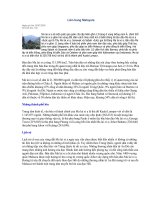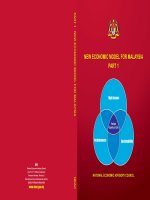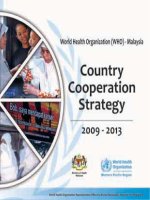(TIỂU LUẬN) dự án mở RỘNG HOẠT ĐỘNG KINH DOANH của VIETTEL GLOBAL tại MALAYSIA
Bạn đang xem bản rút gọn của tài liệu. Xem và tải ngay bản đầy đủ của tài liệu tại đây (602.02 KB, 45 trang )
Trường Đại học Kinh tế - Luật
Khoa Kinh tế đối ngoại
-----
-----
BÀI BÁO CÁO MƠN
QUẢN TRỊ TÀI CHÍNH CƠNG TY ĐA QUỐC GIA
DỰ ÁN MỞ RỘNG HOẠT ĐỘNG KINH DOANH CỦA
VIETTEL GLOBAL TẠI MALAYSIA
Giảng viên hướng dẫn: Th.S Phùng Tuấn Thành
Nhóm thực hiện:
1. Đinh Trịnh Bảo Khánh
2. Lê Thị Thảo Linh
3. Lê Bùi Thảo Nguyên
Tp Hồ Chí Minh, 25/04/2020
Contents
INTRODUCTION ..........................................................................................................................
I. OVERVIEW OF VIETTEL GROUP & VIETTEL GLOBAL ...................................................
1.1
Viettel Group ............................................................................................
1.2
Viettel Global ...........................................................................................
II. Introduction to project. ...............................................................................................................
2.1. Basis of project formation ....................................................................................................
2.2
Overview ..................................................................................................
2.3
Objectives and results. ..............................................................................
2.4
Products and services. ..............................................................................
2.5
Target Market...........................................................................................
III. Business environment analysis .................................................................................................
3.1
Internal environment analysis. ..................................................................
3.1.1
Financial standing ...................................
3.1.2
Human resources ....................................
3.1.3
Technology ............................................
3.2
External environment analysis ................................................................
3.2.1
Malaysia’s Telecommunication infrastru
3.2.2
Policy ....................................................
3.2.3
Exchange rate .........................................
3.2.4
Competitors. ...........................................
IV. Draft financial strategy ...........................................................................................................
4.1
Economic assumption ............................................................................
4.2
Draft initial investment costs .................................................................
4.3
Plan for repayment of the loan principal and interests ...........................
4.4
Draft revenue ..........................................................................................
4.5
Profit and loss estimation ........................................................................
4.6
Financial efficiency .................................................................................
V. Risk of the project evaluation. .................................................................................................
5.1
Risk of competitors. ...............................................................................
5.2
Risk of technological change. ................................................................
5.3
Risk of economic recession. ...................................................................
VI. Business Model .......................................................................................................................
6.1
Target customer. .....................................................................................
6.2 Target value..........................................................................................................................24
6.3 Distribution channels...........................................................................................................24
6.4 Customer relationships........................................................................................................ 24
6.5 Revenue streams..................................................................................................................25
6.6 Main human resources.........................................................................................................25
6.7 Price strategies.....................................................................................................................25
VII. Conclusion and recommendations.........................................................................................25
7.1 Conclusion...........................................................................................................................25
7.2 SWOT model.......................................................................................................................26
7.3 Proposed solution................................................................................................................ 27
References:.................................................................................................................................... 28
APPENDIX STUDYING GROUP............................................................................................... 30
LIST OF TABLES
Table 1: Business results of Viettel Global (2017-2019).................................................................8
Table 2: Financial ratios of Viettel Global (2017 -2019).................................................................9
Table 3: Draft initial investment costs...........................................................................................17
Table 4: Time to disburse investment capital................................................................................ 17
Table 5: Plan for repayment of the loan principal and interests.................................................... 18
Table 6: Project revenue estimation...............................................................................................19
Table 7: Profit and loss estimation................................................................................................ 20
Table 8: Financial efficiency......................................................................................................... 21
Table 9: Financial efficiency......................................................................................................... 22
LIST OF FIGURES
Figure 1.1: The results and success of Viettel Global in foreign market.........................................6
Figure 3.2: Exchange rate of Vietnamdong and Ringgit Malaysia (2017 - 2020).........................13
Figure 3.3: Telecommunications sector revenue 2018 vis-à-vis 2017.......................................... 14
Figure 3.4: Market share of mobile subscribers in Malaysia in 2018........................................... 14
Figure 5.1: Market share of telecommunication company in Malaysia in 2019........................... 23
LIST OF ACRONYMS
STT
Từ viết tắt
2
CF
5
EBIT
Earning before Interest and Tax
6
EBT
Earning before Tax
9
GB
Gygabyte
11
IRR
Internal Rate of Return
13
MNCs
14
NPV
Net Present Value
19
TIP
Total Investmen Point of view
21
TPP
Payback period
23
VND
Việt Nam đồng
24
RM
Tên đầy đủ
Cash flow
Multinational Coporation
Ringgit Malaysia
INTRODUCTION
Foreign direct investment is a basic feature of the current world economy. Developing and
underdeveloped countries are also fully capable and have many opportunities to invest directly
abroad, even invest in developed countries if investors and enterprises are creative, take the
initiative, and appreciate correctly the opportunities. Moreover, foreign direct investment also
creates favorable conditions for businesses to improve themselves, contribute to economic
development, and complete economic policies of the country. In recent years, our government
has issued many guidelines and policies to optimize the benefits of this type of capital flow of
international investment. Offshore investment in general and foreign direct investment in
particular help businesses of developing countries get used to and gradually adapt to regional and
world markets. Therefore, many Vietnamese enterprises choose to invest abroad with the desire
to create new opportunities, in which direct investment abroad is a fairly common form.
Vietnam's direct investment abroad has tended to increase. This is the potential activities that not
only helps businesses expand their markets to recovery and contribute to the country's
development, but also contributes to enhancing Vietnam's position in the process of international
economic integration, especially after The Coronavirus pandemic (COVID-19).
In the field of information technology and telecommunications, Vietnam has many strong
businesses including Viettel Group. The goal of expanding markets abroad is developing and
underdeveloped countries.
Based on all the above, the project “EXPANSION PLAN - MINXITEL” of Viettel Global (a
subsidiary of Viettel Group) was built. The following assignment is the analysis of the feasibility
of the project.
I. OVERVIEW OF VIETTEL GROUP & VIETTEL GLOBAL
1.1 Viettel Group
Viettel Group is currently the largest telecommunications group in Vietnam with 76 million
customers. The group consists of more than 20 subsidiary companies running different types of
business including telecom, investment, real estates, foreign trade and technical services
1.2 Viettel Global
In 2006, Viettel Group decided to extend its business to overseas looking for more potential
markets. Viettel Global was established October 2006 with a vision and responsibility of turning
Viettel into a strong telecommunications group on international stage.
After 9 years of development, Viettel Global is one of the biggest Vietnamese overseas investors.
It is now operating 9 telecommunications companies in 9 countries across Asia, Africa and Asia
with total population of over 175 millions and 13 million customers. Viettel Global embraces a
sustainable investment strategy that balances the benefits of corporate, governments, the people
and customers. They invest in strong network infrastructure covering nationwide and widespread
supplying chain to every village so that our services are accessible to all people in those
countries regardless of their locations and income conditions. Besides, thanks to the long-term
experience from operating telecom business in Vietnam and firm financial foundation of Viettel
Group. Viettel Global can master and apply the latest technology and diversify our services.
Viettel Global is proving its competences through the success of its subsidiaries when most of
them taking the leading positions in their national telecom markets in term of subscribers/
revenue/ infrastructure, for instance, Metfone in Cambodia, Telemor in Timor-Leste or Movitel
in Mozambique.
Figure 1.1: The results and success of Viettel Global in foreign market
II. Introduction to project.
2.1. Basis of project formation
Vietnamese enterprises face fierce competition not only from domestic enterprises but also from
big multinationals in the era of growing international business. In this context, many Vietnamese
firms have bravely invested, reached out to dominate foreign markets and have achieved many
successes. Especially in the field of telecommunications and information technology, Viettel
Global JSC (Viettel Group) is a pioneer in the expansion of the market to international scope and
won many victories. After more than 30 years of establishment and development, Viettel
Telecom has been present in 64 provinces and cities across the country and is now one of the
most reputable and popular telecommunications and Internet service providers in Vietnam and
regions. Moreover, in 2019, Viettel has become one of the top 15 largest telecommunications
companies in the world in terms of subscribers. Besides, the company has been making its mark
on the international arena with 9
Therefore, the project "Minxitel of Viettel Malaysia Telecommunication Joint Stock Company"
was established a subsidiary of Viettel Global to provide telecommunication services in
Malaysia. Not only that, but Viettel Malaysia will also be a premise to expand the market in other
countries in ASEAN. The project is the mission of making Viettel is in the top 10 largest
telecommunications company.
2.2 Overview
•
Name: Minxitel - Coming to Malaysia
•
Vietnamese name: Minxitel - Gia nhập thị trường Malaysia
•
Form of business: Limited Liability Company (100% capital of Viettel)
•
Market selection: Malaysia is the consumer market and manufacturing market
telecommunications provision business and the Internet. However, the main activity is
the consumer market.
•
Business areas: Providing mobile telecommunications services, Internet (TV) services,
equipment (wifi router, SIM card, 4.5G)
•
Investment: 1.5 billion Malaysia Ringgit
2.3 Objectives and results.
•
Legalizing business licensed under the Laws of the host country.
•
Setting up the network infrastructure and the provision of telecommunications services,
Internet (5G) more widely to raise the proportion of people using the Internet.
•
Expanding business areas in the host country: digital wallet system, shipping,...
•
Occupying 5% market share after 1 year of operation, each year increases from 0.5% 2%, item by 2030 reaching 15% market share nationwide.
•
Ranked among the top 3 telecom companies in Malaysia by 2030.
•
Payback period: 10 years
•
The rate of return on annual revenue reaches from 3% to 6%.
2.4 Products and services.
Individual Customer: final consumers of the service. Viettel Global aims to target customers at
the age of 15 - 30 years old (64% internet users in Malaysia), to take advantage of the interest in
experiencing new things and high demand for telecommunications and internet services of this
group.
Business Client: authorized agents, organizations using telephone service, intranet-wifi. This is a
group of customers with high requirements for discounts, the stability of intranet services,
security. According to Malaysian Communications and Multimedia Commission’s report
(Commission, 2018), 70.4% of Internet users are employed, including self-employed.
2.5 Target Market.
Viettel concentrates on mass investment on a large scale and in remote areas. This is a strategic
plan of Viettel Global when entering new market. Although Malaysia has a concentrated
population structure in urban areas which is 2/3 of the population, with an urbanization rate of
75%, Viettel Global will start from rural areas, then urban after building huge penetrated
facilities. Malaysia is a market with a large customer base, while 86% of the population is
considered using the Internet in 2023 and each user can subscribe up to 5 SIM cards per service
provider (Müller, Malaysia: internet user penetration 2017-2023, 2019).
III. Business environment analysis.
3.1 Internal environment analysis.
3.1.1 Financial standing
Table 1: Business results of Viettel Global (2017-2019)
Target
Gross
Revenue
Provide
service
Cost
%
Cost/Gross
Revenue
Profit
%
Profit/Gross
Revenue
Source: Consolidated financial statements 2017-2019 (Investment, 2017))
In terms of revenue, Viettel Global's revenue is not stable, down from 2017 to 2018 but up
slightly in 2018. Revenue in 2018 decreased by 11.3% compared to 2017, in 2019 increased by
1.07% compared to 2018. Viettel Global's main business is providing services accounting for a
large proportion of revenue, accounting for 79.7% in year. 2017 and 92.1% in 2018, this figure
reached more than 89.4% in 2019. From that, Viettel Global is focusing on developing services
and is expanding in this area.
Regarding Viettel Global's profit in the period from 2017 to 2019, the growth is unstable and has
a negative profit in 2 years. Along with that, the company's profit growth rate increased
significantly, in 2018 it was -122.6% compared to 2017, 2019 was 221.5% compared to 2018.
The ratio of profit to revenue also had a volatility, this rate is tending to increase significantly.
Regarding costs, Viettel Global's cost in the period of 2017 - 2019 fluctuates and tends to decrease. In
2018, the company's cost decreased by 8.03% compared to 2017, in 2019 the cost decreased sharply
by 12.2% compared to 2018. In general, Viettel Global's business performance is not high but quite
stable. Although the company has not had a high revenue growth, its net profit has grown rapidly in
the last 2 years. However, the company needs to have a clear, transparent cost management plan and
minimize unnecessary expenses, restructure the production market as well as the consumer market to
limit risks. expenses caused by exchange rates.
Table 2: Financial ratios of Viettel Global (2017 -2019)
Ratios Group
Liquidity
Analysis Ratios
Activity Ratios
Financial
Leverage Ratios
Rate of returns
Source: Consolidated financial statements 2017-2019 (Investment, 2017)
Regarding the Liquidity Analysis Ratios, Viettel Global's indexes had many changes in the
period of 2017 - 2019. Current ratio and quick ratio though increased in 2018 but then decreased
in 2019. Compared to the industry average then these two ratios are lower, but in 2018, the
difference is not significant. In general, the indicators show that the company's financial strength
is not really high, the company needs to have a more effective financial management plan to be
able to compete in the country as well as participate in expanding the market. abroad.
Regarding the Activity Ratios , it can be seen that the company's Activity Ratios tend to decrease
in 2018 but then increase in 2019 except total assets turnover. This shows that the company's
policies of deferred sales as well as inventory management have experienced problems leading to
a low performance of the company but now stable again.
Regarding the Financial Leverage Ratios, the ratio of debt to assets and interest payment ability
of the company tend to decrease in 2018 and increase in 2019. In particular, the solvency of the
company decreased from 1.04 in 2017 to 0.85 in 2018 and then to 3.25 in 2019. The ratio of debt
to assets of the company stood from 64.48% in 2017, this number decreased in 2018 to 57.30%
but in 2019 increased. to 59.38%.
Rate of returns of Viettel Global in this period tends to increase. In 2017, the company's ROA,
ROE, ROS were -0.64%, -1.80%, -2.53%, respectively. By 2018 these numbers decreased
rapidly with a ROA of -1.38%, ROE of -3.07% and ROS of -6.35%. But then these indicators
increased in 2019 and reached the following specific levels: ROA 2.1%, ROE 5.18% and ROS
7.63%. Compared with the industry average, only ROS is higher, ROE and ROA are lower. In
general, although the company's profitability ratio was very low at first, there was a clear
improvement, and positive profit in 2019. In the future, the company needs to improve its
operations. business as well as managing expenses more effectively to achieve high profits.
3.1.2 Human resources
The Corporation always considers human resources as the core element and valuable asset of the
Corporation. The personnel policy of Viettel Global was built with the purpose of turning human
resources into a leading competitive advantage.
Recruitment policy:
The recruitment objective of Viettel Global is to attract talents, prioritize experienced and
capable employees, to meet job requirements and contribute to the Corporation's long-term
development strategy. Recruitment is based on labor demand. Viettel Global conducts auditions
with certain standards set by the Corporation. Recruitment criteria are based on the qualities,
potential and goodwill of each candidate.
Education policy:
Professional competence: The company always focuses on in-depth training for employees to
improve skills, qualifications, support employees in personal career development as well as
increase efficiency in the job. Not only training Vietnamese staff, Viettel Global also focuses on
training and transferring knowledge to local staff. Every year, Viettel Global organizes short-term
training courses for 3-6 months for foreign employees to study and experience work in Vietnam.
As a result, the entire company in the market now has local personnel transferred to important
positions in the Subsidiaries after training: Deputy General Director, Head of the Company,
Director Chi branch (Company, 2018)
3.1.3 Technology
Viettel Global is a subsidiary of Viettel Telecom so it inherits and uses all the technologies of the
parent company.
Not only doing business in the field of mobile telecommunications, Military Telecom Corporation
- Viettel also pioneers in many new technologies. Specifically, Viettel is the first network
operator to deploy 4G service in Vietnam. In April 2017, this Viettel deployed 36,000
broadcasting stations in 6 months, covering 95% of the population. Statistics by the end
of March 2018 showed that there were 10.6 million 4G subscribers on Viettel network.
Not only popular in urban areas, big cities, 4G Viettel has crept into the most remote and
mountainous provinces of the country, bringing learning and career opportunities to many
people. Besides, 4G technology has also become the foundation for implementing many
important 4.0 projects of society and government.
Viettel is also one of the first enterprises to deploy cloud computing (Cloud) in 2008, this is also
the first telecommunications enterprise to launch cloud services in Vietnam. and Viettel's data
analysis system is currently among the best in Asia with 4.5 / 5 points, according to the
evaluation of the world's leading consulting firm BCG. (D.L, 2020)
After 10 years of establishment and development, Viettel's cloud computing market share is at
the top of the market with over 16%, far ahead of competitors such as FPT or VNPT. In 2017,
Viettel IDC was the first and only domestic unit to be granted the first and only Enterprise
Service Provider certificate of VMWare in Vietnam.
Currently, Viettel IDC is also the only provider in Vietnam to provide a full service ecosystem to
customers: from computing (compute), network (networking), storage (storage), security and
security. (security), management services (manage services), data recovery (Dr as a service) and
other services. In the future, Viettel's Cloud will be exported to Cambodia and Myanmar.
In the field of manufacturing technology, Viettel impresses the whole world with the unmanned
aircraft (UAV) that is displayed at the Indo Defense Exhibition, even if it only shows the small
unmanned aircraft. called Shikra with a weight of 26 kg and a wingspan of 3.5m. In addition,
Viettel is developing Viettel Network Security Company. The company continues to set the
number 1 goal in the field of Information Security Monitoring and Troubleshooting Services
(ATTT) 24/7, Testing and Assessing Information Security System and Application, Review
Service control malware removal (VŨ, 2019)
3.2 External environment analysis
3.2.1 Malaysia’s Telecommunication infrastructure
According to report of Malaysia - Telecoms, Mobile and Broadband - Statistics and Analyses by
Paul Budde Communication Pty (Ltd, 2019), Malaysia is one of the few developing countries
which has advanced telecom networks by the widespread application of many modern
technologies such as fiber optics, wireless transmission, digitalization and satellite services in
building its telecom networks. Besides, Malaysia also has strongly backed the roll-out of a
national broadband network thanks to the substantial participation of its government in ICT
development which also is a particular characteristic of the Malaysian market.
There was a significant growth in
mobile broadband penetration over
the past seven years driven in
Malaysia by the strong growth of
4G mobile subscribers and high
data caps (Ltd, 2019). This means
the
telecommunication
infrastructure is improving yearly.
The number of internet users in
Malaysia is accounting for 64% of
its population and is predicted a
continuing increase in the next 3
years. This is a great market for
telecommunication industry.
Figure 3.1: Number of internet users in Malaysia from 2017 to 2023
Source: (Müller, Number of internet users in Malaysia from 2017 to 2023, 2019)
Moreover, the Malaysian government has been launching the ‘National Fibre Connectivity Plan'
in 2019. This plan aims to develop broadband infrastructure to ensure more efficient spectrum
allocation to achieve the targeted 30Mbps speed in rural and remote areas within five years.
3.2.2 Policy
Despite being a federal country and having a diverse culture from lots of people, Malaysia
maintains a stable political institution and has many policies to encourage immigration and
investment from abroad.
This country is famous for tax-friendly comparing to many countries. In 2016, the standard
Corporate Tax Rate in Malaysia is 24%, reduced from 25% in 2015 (Guide to taxes in Malaysia
[brackets-incentives], 2018), and still keep imposing a Tax on Goods and Services at a standard
rate of 6%. Besides, all procedures which create troubles for foreign investors are gradually
eliminated and replaced by mechanisms, procedures that are fast, compact and efficient.
3.2.3 Exchange rate
The chart has shown Malaysia Ringgit exchange
rate has fluctuated in the past 3 years. In March
2018, this currency reached a peak of nearly
5,9000 VND/MYR, then went down slowly.
In general, Malaysia Ringgit is appreciated more
than Vietnam Dong and can be considered a
strong currency.
Therefore, Malaysia could become a potential
consumer market that Viettel can exploit.
However, when opening its subsidiary in
Malaysia, the company should pay attention to
the application of exchange rate risk hedges to
the constant fluctuation of Ringgit
Figure 3.2: Exchange rate of Vietnamdong and Ringgit
Malaysia (2017 - 2020)
Source: VersaFX
3.2.4 Competitors.
Since 2012, the telecommunication market of Malaysia was competitively dominated by three
major mobile operators: Celcom, Digi, Maxis, and TM Berhad. In 2018, the largest telecom
operator in Malaysia is TM with 33% revenue of market share, followed by Maxis with 26% and
Celcom with an estimated 20%.
As 3G licenses began to be provided, the boost in the market witnessed the appearance of a
fourth telco: U Mobile. In 2018, the telecommunications sector revenue had increased by 3.7%
to RM35.86 billion from 2017, with mobile operators contributing a huge chunk equivalent to
64% of the total revenue. The remaining 36% was generated by fixed service providers.
Figure 3.3: Telecommunications sector revenue 2018 vis-à-vis 2017
However, the chart shown that Digi commanded the largest subscriber market share at 28%
compared to Maxis 33%, while Celcom remained a distant third at 21%.
Figure 3.4: Market share of mobile subscribers in Malaysia in 2018
Source: (Müller, Market share of mobile subscribers in Malaysia in 2018, 2019)
For more detail, we provide this table to sum up 6 biggest telecommunication companies in
Malaysia:
No.
1
Company name
Maxis
Communications
2
Celcom (Axiata)
3
Digi
Communications
4
Telekom
Malaysia
5
6
U mobile
Time dotcom
IV. Draft financial strategy
4.1 Economic assumption
Analyzing the economic-financial efficiency of the project during the period of 50 years, after
the construction period of 12 months. This project will be active from December 2021. The
financial draft of this project will be calculated in the Malaysia currency (RM).
-
Interest of commercial banks is about 6.5%/ year => financial risk occurs because
businesses have to bear a fixed interest rate.
- The number of periods of principal payment: 5 years
- Machinery equipment depreciation rate: 9%
- Corporate income tax: 24%
- Average inflation: 4%/year
- Commodity price: RM8 (increasing by 0.5% per year)
- Office rental price: RM18,000/month.
- Estimated annual cash fund /operating expenses: 10%
- Percentage of annual payables/operating expenses: 15%
- Percentage of annual revenue/turnover: 10%
- Residual value of machinery and equipment: RM123050000
- Annual growth rate of salary: 5.75%/year
- Target market share: 5%/year (1% - 2% increase annually)
- Growth rate of service use nationwide: 10,5%
4.2 Draft initial investment costs
Based on the investment strategy of Viettel Global, the expenses that the company must pay to
implement the project include fixed costs and operating costs such as office rental costs, fiber
optic cable investment costs, construction pylons - BTS (Base Transceiver Station),... the detail
will be shown on the table. The total estimated investment cost for the project within 50 years is
about 1,5 billion MYR. Details of initial investment costs are shown in the table below.
Table 3: Draft initial investment costs
Items
Total initial investment
Rent the head office
Rent distribution agency office
Equipment
Telecommunication
infrastructure
Installation (25%)
Common use of infrastructure
(75%)
Business activities
Other costs
The table below illustrates this project capital disbursement in 3 specific periods:
Table 4: Time to disburse investment capital
Time of capital disbursement
The first period
Jan 2021
The second period
June 2021
The third period
Dec 2021
4.3 Plan for repayment of the loan principal and interests
The VND is predicted to depreciate in the future, therefore, Viettel Global decided to borrow this
project's capital from Vietcombank Commercial Bank in Vietnam currency with a preferential
interest rate of 6.5%/year and the repayment principal period is 5 years. Moreover, by borrowing
in VND, after having revenues and profits from a subsidiary in Malaysia, the currency
transferred from MYR to VND will have a better exchange rate opportunity. It is also a lucrative
way for the company. Details of the repayment schedule for both principal and interest are
illustrated in the following table:
Table 5: Plan for repayment of the loan principal and interests
Items
Opening Debit
Interest arising in
the period
The amount of debt
payment
Repayment of
principal
Repayment of
interest loans
Closing balance
Increased debt
4.4 Draft revenue
Activities that generate revenue:
- Revenue from telecommunications services business accounted for 40% of total revenue
- Internet - Television service business, accounting for 40% of total revenue
- The business of accompanying services such as 4G sim, 4G Router Wifi devices, ... accounting
for 20% of total revenue.
- To facilitate the calculation of revenue, the project only calculates the revenue from Internet
service provision and the total revenue will be based on the proportion of each activity.
Revenue calculation:
The volume of data consumption in Malaysia in 2019 was estimated at about 320 million GB
with the average growth rate at about 10.5% per year. The company sets a target for winning a
5% market share by the project in 2021. The market share of this project is expected to increase
by 0.5% - 2% per year. In 2030, the company will basically reach a 15% market share in the
telecommunications market in Malaysia. Based on the above facilities, the revenue of the project
for the period of 2021-2030 is constructed as the following table:
Table 6: Project revenue estimation
(Unit: million MYR)
Categories
Internet revenue (40%)
National 1-year use
data (million GB)
Market share (%)
Price for 1GB / year
Mobile service revenue
(40%)
Other service revenue
(20%)
TOTAL REVENUE
4.5 Profit and loss estimation
The profit-and-loss situation is the criterion that determines whether a project can be invested or not.
Profit is the goal that all companies are aiming for, so the profit and loss drafting is an important step
to determine whether the project is effective or not, therefore, the company has a clearer view of
business operations of the project, so they can decide to make an investment decision or not. The
table below details the draft profit and loss of the Mixitel project in Malaysia:
Table 7: Profit and loss estimation
(Unit: million MYR)
Các chỉ tiêu
1.
Tổng doanh thu
2.
Các khoản giảm trừ
- Giảm giá
- Hàng bán bị trả lại
3.
Doanh thu thuần
4.
Chi phí hoạt động
5.
Khấu hao
6.
Lợi nhuận trước thuế và lãi
vay phải trả (EBIT)
7.
Lãi vay phải trả
8. Lợi nhuận trước thuế (EBT) =
(6)-(7)
9. Thuế thu nhập doanh nghiệp
= (8) x 24%
10. Lợi nhuận thuần sau thuế =
(8) - (9)
4.6 Financial efficiency
The Mixitel project is an important business expansion project of Viettel Global because this is the company's first step into Malaysia.
The estimated payback period is 10 years, with this estimated payback period for details of financial performance is presented in the
following table:
Table 8: Financial efficiency
(Unit: million MYR)
Năm hoạt động
Các yếu tố
2021
A. Dòng tiền vào
Doanh thu
Chênh lệch khoản
phải thu
Giá
(thanh lý đấy, máy
móc…)
trị
cịn
lại
Tổng dịng tiền vào
(CF)
B. Dịng tiền ra
Đầu tư vào văn
phịng
Đầu
móc thiết bị
Chi phí hoạt động
476,60
tư
vào
máy
1.000,00









